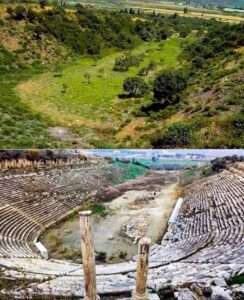The Stadium of Magnesia on the Maeander, situated in present-day Turkey, represents a historical marvel dating back to the 2nd century BC, amidst the flourishing Hellenistic era. Nestled organically into the natural incline of a hillside, this ancient Greek stadium boasted a grand capacity of around 30,000 spectators, solidifying its standing as one of the era’s most colossal sports arenas.
With a distinctive design featuring a lengthy, slender track enveloped by seating arrangements in a U-shaped configuration, the stadium was purpose-built to host a myriad of athletic competitions, notably foot races and other contests intertwined with religious festivities. An element that sets this stadium apart is its remarkably preserved vaulted passageways through which athletes made their grand entrances, adding a touch of theatricality to their arrival on the field.

The inception of excavations, commencing in the early 20th century and persisting intermittently, has unearthed substantial sections of the stadium, revealing its seating areas, starting lines, and several inscriptions. These discoveries serve as invaluable portals offering insights into the architectural techniques employed in construction and the profound cultural significance attached to the stadium.
Today, the site exists as a testament to the ingenious architectural endeavors of ancient Greek civilization, immortalizing the enduring essence of communal sports within Greek society. The remarkable preservation of the Stadium of Magnesia on the Maeander stands as a vivid reflection of the rich historical tapestry woven by the Greeks, further enriching our understanding of their architectural prowess and the monumental role sports played in their cultural milieu.





